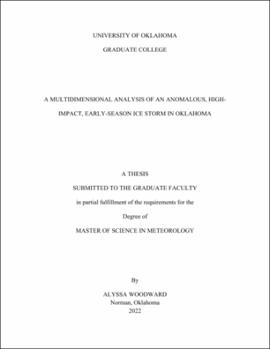| dc.description.abstract | Between 26 to 28 October 2020, an anomalous, high-impact, and early-season ice storm affected much of Oklahoma. This was the first time the National Weather Service (NWS) Forecast Offices in both Norman and Tulsa had issued an ice storm warning during the month of October and the event is the earliest ice storm in the last 40 years. Overall accumulations were consistent with past ice storm events, but the early season nature of this event led to higher impacts due to increased surface area for accumulations on trees that retained leaves from the growing season. This resulted in branch failures, many downed powerlines, and widespread power outages. Due to the early-timing and severe impacts the goal of this study is to investigate the evolution of the event and identify critical physical processes. First, the synoptic-scale and mesoscale features associated with the event were examined. At the synoptic-scale, a 500 hPa Alaskan ridge, ample 700 hPa moisture transport from the eastern Pacific Ocean region, and the progression of cold 850 hPa temperature anomalies from Canada were all noted 14 days before ice storm onset. At the mesoscale, deep-tropospheric ascent contributed to the significant, localized heavy precipitation across central Oklahoma that was collocated with an anomalous, shallow cold air mass. Second, the October 2020 ice storm was compared to 12 past ice storms in Oklahoma that occurred between 1996 and 2017 to investigate whether the synoptic-scale patterns of an early-season storm differ from normal winter season events. The results yielded similar overall patterns, however, the magnitude of anomalies was generally greater for October 2020 than other past cases. Finally, a potential predictability signal was identified where the geopotential height pattern of past ice storms exists simultaneously with cold 2-meter temperature anomalies over much of the CONUS spanning up to two weeks before event onset. | en_US |
